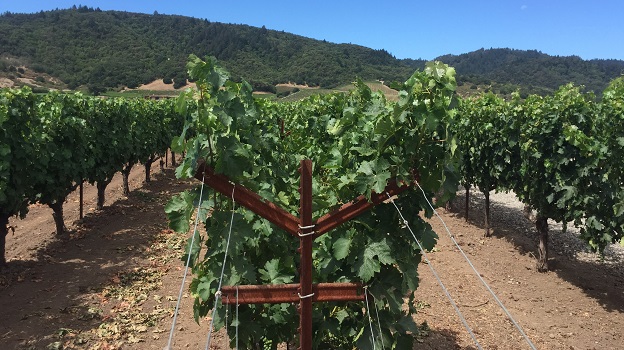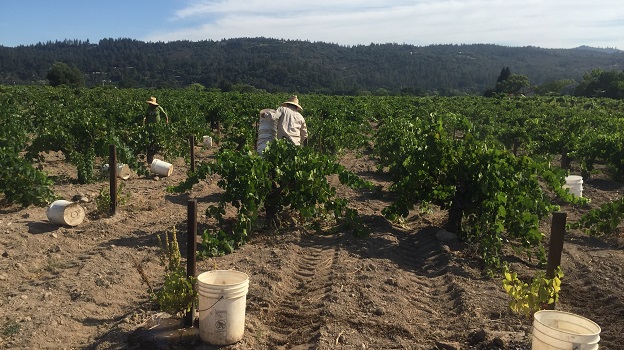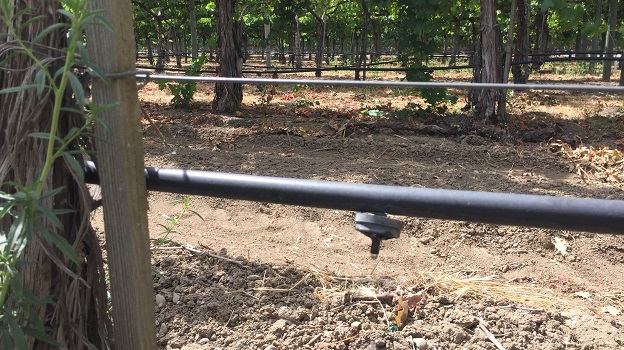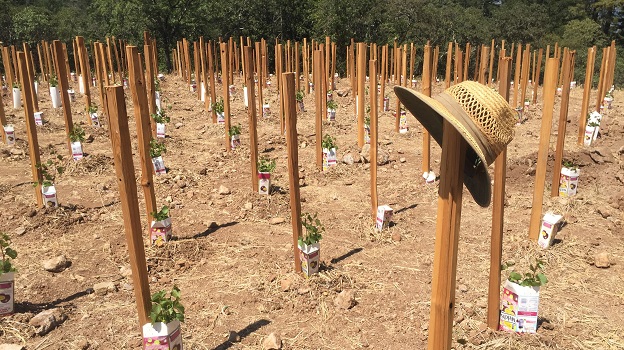Browse using the new Vinous website now. Launch →
Printed by, and for the sole use of . All rights reserved © 2015 Vinous Media
Dry Times in Napa Valley
When Christian Moueix founded Dominus in the early 1980s he predicated his investment on three conditions, and said “I require 20 years to make a great wine. And I can only do this with a property that does not require acidification or irrigation.” Hailing from Bordeaux, where irrigation is outlawed, Moueix’s position was not necessarily surprising. But in California, where the rules are altogether more lax, many growers rely on irrigation not only to establish their vineyards, but to support them in what can at times be especially hot and dry growing conditions. The debate between dry-farming proponents and those who favor irrigation has always been intense, as the topic seems to inspire a great deal of passion, but with the current drought afflicting the state of California, conversations have taken an almost political turn.
The dry-farmed vines of Dominus look verdant and healthy even in a drought
What is Dry-Farming?
Strictly speaking, a dry-farmed vineyard receives no water, not even for emergency heat wave relief. The only exception to this is the first three years or so of a vineyard’s life, when irrigation is often employed to establish the baby vines. While some growers will water the young vines by hand, others prefer to string up irrigation lines, which is why some mature, dry-farmed vineyards remain decked with black hoses long after they’ve been weaned off of water. Of course, it is important to note that “dry-farmed”, much like “old vines” or “reserve”, is not a legally protected or enforced term, so its presence on a wine label or website does not necessarily guarantee total observance.
Workers setting up buckets to water newly planted rootstock in the Library Vineyard
Critics of dry-farming may paint the practice as lackadaisical, but successful dry-farming is about more than simply not irrigating—the soils must be biologically healthy, non-compacted, and able to retain moisture naturally. In order to achieve this, complex cover crop treatments are required, as is thoughtful canopy management, investment in lightweight machinery, regular tilling (depending on the site), and constant, careful observation.
The History of Irrigation in Napa Valley
Once upon a time, the vast majority of Napa Valley was dry-farmed. Primitive methods of irrigation were occasionally employed, but growers typically found the winter rains sufficient for the establishment and maintenance of their vines. Historian Charles Sullivan even goes so far to argue that part of the early success and mystique of Napa Valley was that it was widely known to be dry farmed, which was thought to add to the quality of its wines.
Andy Beckstoffer, one of Napa's biggest landholders, introduced drip irrigation to the valley in the 1970s
Modern-day drip irrigation was invented in Israel and subsequently introduced in the Napa Valley by Andy Beckstoffer in the early 1970s. Beckstoffer viewed the new technique as key to developing Carneros, which had historically been difficult to cultivate because of the presence of an impenetrable clay hardpan a mere three feet below the surface of the soil. This solid layer prevents roots from tunneling deep enough to secure their own moisture, which is critical in Carneros where the average rainfall is low and the vines are constantly battered by strong, dehydrating winds. True to Beckstoffer’s vision, drip irrigation revolutionized viticulture not only in Carneros, but all over Napa Valley, where it helped facilitate the region’s boom of the late 1970s/early 80s. Sites once considered marginal were developed, yields increased and/or stabilized, and growers were able to move away from expressly drought-tolerant rootstocks towards those that provided greater pest resistance, higher yields and other desirable qualities.
A drip emitter
Another critical step in Napa Valley’s viticultural evolution came in 1986, when massive flooding spread phylloxera throughout the valley. Because many of Napa’s new vineyards had been planted on the phylloxera susceptible AxR1 rootstock, widespread replanting was required by the early 1990s, once the symptoms began to manifest themselves. Most vintners used this tragedy as an opportunity to completely reengineer their vineyards. As a result of the replant, Cabernet Sauvignon became the dominant variety in Napa Valley for the first time, and head-pruned “California sprawl” trellising was largely kicked to the curb, often replaced by VSP (Vertical Shoot Positioning, in which the vines’ shoots are trained straight upwards and along wires) and high-density planting. Many of these newly implemented practices were lifted straight from Bordeaux, the model after which modern Napa Valley was fashioning itself. Of course, Napa and Bordeaux are home to vastly different climates; not only is it far warmer and more sunny in California, it is also significantly drier. In order for these modern, Bordeaux-inspired vineyards to function at their expected level, considerable irrigation was required.
The Benefits of Dry-Farming vs. Irrigation
At first glance, the benefits of irrigation seem obvious – after all, what plant doesn’t want water? - while the advantages of dry-farming appear more intangible and aesthetic. Aside from its critical role in developing more marginal or rocky sites and in the mitigating harsh weather conditions, irrigation also allows for higher yields, greater consistency of yields, and arguably more consistency in quality—though whether that last characteristic is good or bad is a matter for a whole other debate. Alex Kongsgaard, who farms the irrigated Stonecrest (AKA Judge) vineyard for his father admits that irrigation can often be an element of the “international” wine style, and that it is definitely a key aspect of modern Napa Cabernet production, in which every part of the vine growing and winemaking process is micro-managed and tweaked according to a final, often stylistic, goal.
Consider the grower’s perspective. Andy Beckstoffer is one of the biggest names in wine grape production in northern California. His company currently farms 1,000 acres in Napa and Carneros and 3,000 acres in Lake and Mendocino counties. In Napa Valley, his grapes command some of the highest prices in the whole world of wine. At this level, quality is key but consistency is also a huge factor. Indeed, Beckstoffer irrigates 100% of his vineyard holdings, even those such as To Kalon, that have a long and illustrious history under dry-farming. For Beckstoffer, irrigation is paramount to grape quality, especially in a drought, and he believes that if the current conditions continue, “dry-farmers” will have no choice but to water their vines, at least a little. Tegan Passalacqua takes the opposite position. Passalacqua, who is Larry Turley’s winemaker and vineyard manager, oversees more than 30 vineyards across northern and central California, roughly half of which are dry farmed. Passalacqua maintains that, in major droughts, it’s the trees planted near the riverbanks and not those in the plains that die first. “Irrigated vines have bigger stomata, bigger veins; they process water a lot less efficiently than dry-farmed vines.” Bred for performance, Passalacqua likens such vineyards to sports cars in that they burn a lot more gas, a lot more quickly, than is typical.
The old vine, dry-farmed Library Vineyard has been an exciting source of fruit for Turley for many years
Advocates of dry-farming also believe that theirs is the best tasting fruit. Moueix and his long-time team of winemaker Tod Mostero and viticulturalist Guillaume Eicholz are so deeply in tune with their vineyard that they are able to detect a leaky mister based solely on the diluted flavor of the nearby fruit. They are not alone-- the valley is full of anecdotes where the fruit from non-irrigated blocks shows better depth and concentration of flavor than adjacent, irrigated blocks, even when the chemistry is identical. Even Beckstoffer agrees that dilution is a real threat, confessing that “dry-farming is certainly better than over-irrigating,” at least in terms of fruit quality.
There are physical reasons for this reported difference in taste. A vine’s growth is triggered by the roots, which send hormonal signals through the plant when the surrounding soil is warm and dry enough to indicate a change in seasons. Aggressive irrigation can delay this, and it can also delay the hormonal signifier to begin lignification. As Passalacqua explains, it’s in the plant’s best interest to ensure that the seed is hearty, hard, and brown before the berry becomes fully ripe and attractive to animals, so that it will survive the digestive system. Delayed lignification can result in sugar-rich fruit that is not physiologically ripe. In the cellar, this may translate to a wine with green, hard tannins or—if the winemaker waits to pick—an overripe or jammy wine.
Dry-farmed vines also tend to form deeper roots with denser wood and a more narrow vascular system, as well as more naturally spare canopies. When handled properly, these attributes can make for an improved resistance to disease, fungus, and pests.
Can Any Vineyard Be Dry-Farmed?
Yes and no. When Dominus purchased the Schmidt Ranch in 2008, the vineyard had been irrigated for years; in lieu of weaning the vines off slowly, they simply turned off the water. Much to their delight, the vines showed no signs of distress. Such a happy result is not always the case, however. At Kongsgaard’s Stonecrest vineyard—the site of a former rock quarry—the soil only extends for 2 feet before hitting solid bedrock. This shallow a root zone necessitates regular irrigation, and though Alex Kongsgaard has dialed the amount of water back considerably over the years, he fears that anything less will kill the vines.
The general consensus seems to be that truly successful dry-farming needs to be engineered into the initial design of the vineyard. When the vines are planted too close together, the competition for moisture and other resources can become too great to be viable. Soil type is also a factor, as are rootstocks and, to a lesser extent, variety. Steve Matthiasson’s home vineyard is only 3 acres in size, but is a veritable checkerboard of soil types. Within the vineyard are patches that Matthiasson dry-farms, and others that he has to water regularly. Such variegation is not uncommon in Napa Valley. In general, loam-rich soils, such as those on the valley floor or the lower stretches of alluvial fans, are great candidates for dry-farming. Extremely rocky or sandy vineyards, on the other hand, or those with shallow rooting zones, often require at least a little irrigation to thrive.
Ideally, dry-farming is engineered into the vineyard's design before it is even planted
Finding A Middle Ground: Deficit Irrigation and Technological Advances
Steve Matthiasson occupies an interesting position in the irrigation debate. Though in his home life the ecologically-minded Matthiasson practices extreme water conservation, he is less strict when it comes to the vineyards where he consults. Matthiasson works with a range of clients up and down Napa Valley, and while he aims to water as little as possible, he claims he’d rather irrigate lightly than practice the level of tilling that is often required to maintain dry-farmed soils (tilling can lead to erosion, and releases CO2 into the atmosphere). That said, Matthiasson operates on a case-by-case basis, saying “in super vigorous soils, the best quality comes from dry-farming. But with other soil types, a little irrigation can be qualitatively superior to dry-farming. When it’s 110 degrees on Labor Day, a light watering makes for better fruit.” One thing that all growers seem to agree upon is the advantages of deficit irrigation. In deficit irrigation the vines are not watered until the growing season is well underway, typically at around the start of veraison. In this way, the plant is not encouraged toward excess vigor, and ripening is not delayed, but the vine is supported through the hottest part of its growing season.
Matthiasson works with a range of water monitoring technologies, including a new system wherein the evaporation of a vineyard’s canopy is measured and analyzed. More often than not, these findings help a producer maximize the benefits of irrigation, while dramatically reducing the total amount of water applied.
Though abuses still occur (I have personally witnessed drip lines and sprinklers running during more than one heavy deluge), irrigation seems to be getting more streamlined in Napa Valley. “We are absolutely irrigating less today than we used to in the 1970s and 80s,” admits Andy Beckstoffer. “Everything has become much more scientific. We used to just turn the water on every so often. Now we have probes going down three feet down into the soil, and can read the results off of monitors in our pickup trucks while driving down the road.”
At Ovid high up on Pritchard Hill, irrigation is a high-tech affair. There, the winemaking team employs the increasingly popular Fruition Sciences sap flow monitoring technique to help them customize and maximize the efficiency of their watering habits. With this method, a collar is wrapped around the cordon or cane of the vine, and measures how much water is flowing through the plant based on heat differentials. Combined with information gleaned from local weather stations, this information tells the vintner how much stress the plant is under, and what its water requirements are. Austin Peterson, winemaker at Ovid, explains that this data helped them understand not only how much water to apply to their vines, but also at what times. “We found that small, weekly irrigations did not fully saturate the root zone, and this was causing problems. The roots closest to the surface would send hormonal signals telling the vine it had access to more water than it actually did. This disrupted the plant, and would trigger dehydration of the fruit. Now we withhold irrigation for as long as possible, and then make sure to thoroughly saturate the root zone when we do water.”
The Drought, Napa, And The Future
Due to the particularities of Napa’s geography, the region is far less reliant on melted mountain snowpack for its water than is the rest of the state. Instead, the majority of Napa’s groundwater is fed by the region’s winter rains, which, though far below average these past few years, have still been sufficient to satisfy much of Napa’s current requirements. To put it into perspective, an average winter rainfall in Napa Valley ranges from around 25 to 45 inches. In 2013, the Napa Valley Vintners reported only 6.34 inches. So far, 2015 is not faring much better.
Currently, Napa’s groundwater use is largely unregulated, but that is slowly changing. Coombsville, Napa’s newest sub-appellation, was the first to require monitors on wells for any new development, or any redevelopment. When Andy Erickson and Annie Favia purchased a home and planted some Sauvignon Blanc in Coombsville (a property they have since sold), they specifically designed their vineyard to be dry-farmed because of the area’s strict water use policies. Many observers in Napa Valley believe that more and more sub-appellations will move to pass similar measures, but so far nothing is in the works.
Even in dry-farmed vineyards, newly planted vines must be watered for the first few years
For now at least, the decision to dry-farm or irrigate remains a personal one. For some, dry-farming is the best and only way to truly communicate terroir, while others view irrigation as the duty of the responsible farmer. As with all things in wine, both sides are overflowing with passionate rhetoric. “The debate is often more philosophical than scientific,” says Alex Kongsgaard, “like the topic of sulphur use or native yeast. Some people say you can’t make good wine with irrigation; to me, that’s like saying you can’t make good wine using temperature controlled tanks,” arguing that irrigation is just one in a long series of decisions that shape the final outcome of a wine. Given the drought, however, emotions are high. Austin Peterson bemoans, “There seems to be a thought among consumers that dry-farming is good and everything else is bad, and that if you’re not dry-farming you’re irresponsible. But the truth is, certain sites, like Ovid, simply can’t exist without some level of irrigation.” Steve Matthiasson sees parallels in the water debate to other environmental squabbles, “I believe that key resources should be managed, not shut down. Take for example salmon. We don’t outlaw salmon fishing and we don’t fish it to extinction; it is controlled.”
But for some in the dry-farming camp, their reasons extend beyond the philosophical, ecological or qualitative. Tegan Passalacqua argues that dry-farming, and talking about dry-farming can elevate wine beyond a luxury product and root it more firmly in the land. “People need to understand that in drought years there is going to be less wine. This type and level of knowledge will bring us closer to the planet, and closer to the wines as well. It is vintage variation more than anything else that tells the story of agriculture.”
You Might Also Enjoy
Christian Moueix on Dry Farming
Andy Beckstoffer on Trends in Farming
A Conversation with Ketan Mody
Steve Matthiasson on California's Drought
--Kelli White







